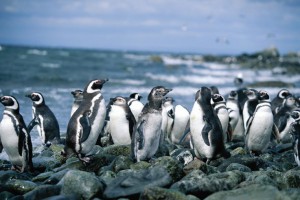Take on an unforgettable nineteen night South American adventure that seamlessly blends culture, history, and natural wonders. Begin your journey in Lima, Peru, where modern sophistication meets ancient charm. Explore the mystical Sacred Valley, immersing yourself in the rich Incan heritage before reaching the iconic Machu Picchu, where breathtaking landscapes meet archaeological marvels. Traverse the Andean Explorer train to Lake Titicaca, where the world's highest navigable lake unfolds its captivating beauty. Dive into the vibrant traditions of local communities on its shores. Concluding your South American odyssey, set sail on a mesmerizing Galapagos Islands cruise, discovering the archipelago's unique biodiversity and pristine landscapes. Each day unveils a new chapter of awe-inspiring beauty, from diverse wildlife encounters to untouched beaches. This meticulously crafted journey promises an unparalleled fusion of history, natural wonders, and luxury, leaving you with memories to last a lifetime.
Isla Baltra
Isla Baltra
Today Baltra is the most important airport of Galápagos and a small navy base for Ecuador. Baltra has suffered most from human settling and does not have any visitor sites. Many cruises start from the its harbour and already there pelicans and noddies will welcome you.
To the north lies Mosquera, a small sandy bank with a large colony of sea lions. Go swimming and snorkeling on the beach.
|
|
Isla Fernandina
Isla Fernandina
From a chance to walk on recent lava flows to the opportunity to see the endemic flightless cormorant up close, this island offers it all.
|
Destination Guide
|
Punta Vicente Roca
Punta Vicente Roca
Located at the ‘mouth’ of the head of the sea horse, which forms the northern part of the Galapagos islands, is Punta Vicente Roca, Here the remnants of an ancient volcano form two turquoise coves with a bay well protected from the ocean swells.
The spot is a popular anchorage from which to take panga rides along the cliff that are the remains of the volcano or explore a partially sunken cave at the water’s edge. Masked and blue-footed boobies sit perched along the point and the sheer cliffs, while flightless cormorants inhabit the shoreline.
The upwelling of coldwater currents in this part of the Galapagos, give rise to an abundance of marine life which, in combination with the protection of the coves, make Punta Vicente Roca one of the archipelago’s sough after dive spots.
One cove is only accessible from the sea by way of an underwater passage. The passage opens to calm waters of the hidden cove where sea lions like to laze on the beach having traveled along the underwater route. The entire area of Punta Vicente Roca lies on the flank of 2,600 foot Volcano Ecuador.This is the Galapagos island’s sixth largest volcano. Half of Volcano Ecuador slid into the ocean leaving a spectacular cutaway view of the volcanic caldera.
|
|
Isla Santiago
Isla Santiago
Also known as San Salvador or James, Santiago is the fifth-largest and one of the most visited of the Galapagos Islands. It is uninhabited, and there was a failed attempt at colonizing it in the 1930s. There are three visitor sites, and the two on the western coast of the island are Puerto Egas and Playa Espumilla.
Puerto Egas, on James Bay, offers a black-sand landing beach with impressive wind-carved, tuff-stone layers. The relatively flat, black-lava shoreline is broken up by pools, caves and promenades, where hundreds of marine iguanas sun themselves, seek mates and slither into the sea. Their black skin camouflages them among the lava rocks.
Playa Espumilla is a nesting area for sea turtles and, when the lagoon is filled, a place to see white-cheeked pintail ducks and flamingos. The estimated flamingo population on the Galapagos is around 500-1,000. These animals are an endemic subspecies of the flamingos commonly found in the Caribbean region.
Dozens of bright red-orange Sally Lightfoot crabs, among the only people-shy creatures on the islands, frolic in the tide pools and scurry on the rocks. The area also has a colony of fur seals, which are endemic to the islands but closely related to fur seals in Antarctica. The snorkeling is good along the rocks, where it's possible to see colorful fish, moray eels and sharks.
At the east end of the island is Sullivan's Bay (across from Bartolome Island). A volcano spewed a stream of lava there in 1897, and it still reaches to the sea. Visitors can follow a marked trail over the lava to see fascinating untouched volcanic formations such as pahoehoe lava. Only a few plants have taken hold there, including an unusually shaped cactus and some carpetweed.
Sombrero Chino (Chinese Hat) is a popular snorkeling spot 656 ft/200 m off the coast. These beautiful waters are a playground for sea lions, sharks, penguins and manta rays. A series of seven diving sites offer divers the chance to get up close to the best of Galapagos' marine life.
|
Destination Guide
|
Sullivan Bay
Sullivan Bay
Sullivan Bay is located on the southeastern region of Isla Santiago belonging to the famous Galapagos Islands. This destination is known for its lava fields that many visitors enjoy exploring. This area of the Santiago Islet was active only 100 years ago and volcanic overflows still are remnant today.
|
|
Isla Bartolome
Isla Bartolome
This small, barren island offers guests the opportunity to observe firsthand its volcanic formations and moon-like landscape.
|
Destination Guide
|
Charles Darwin Station
Charles Darwin Station
The Charles Darwin Station offers insight into ongoing research and conservation in the Galapagos.
|
|
Puerto Ayora
Puerto Ayora
Puerto Ayora is located on the southern end of Isla Santa Cruz. Puerto Ayora is a charming port town where sea, sun, seabirds and sailboats coexist. On the town's outskirts are the headquarters to the world-renowned Charles Darwin Research Station. Many travelers just pass through on the way to see Lonesome George (a 150-year old tortoise; the last of his species) at Darwin Station. Puerto Ayora is a lively seaside town offering international cuisine, oceanfront hotels, outdoor bars, scuba diving schools and an avenue of boutiques with everything from tie-dyed sarongs to Panama hats. Relish the Islands' crescent slices of sand, spectacular diving, mountain top vistas, and tropical climate. Visit select islands and choose from an array of outdoor activities, such as kayaking, scuba diving, snorkeling, horseback riding and mountain biking. Puerto Ayora provides the most convenient base for island hopping. Three boats, the Delphin, Esmeraldas III and Santa Fe, offer day trips to Florena, Bartoleme, North Seymore and Plazas.
|
|
Isla Santa Cruz
Isla Santa Cruz
Here, the Charles Darwin Station offers insight into ongoing research and conservation in the Galapagos. Also located on this island is Cerro Dragon, one of the best places to spy land iguanas.
|
Destination Guide
|
Quito
Quito
Quito is a fantastic place to visit and the best place to start your Latin American journey. Quito is also the entertainment center in Ecuador with new bars and discos opening every week and also the best place to shop, either at the small souvenir shops or at big malls. Quito has many interesting cultural sites, historical sites, museums, private galleries, churches, exhibition centers, and theaters.
|
Destination Guide
|
Galapagos Islands
Galapagos Islands
The Galápagos Archipelago is a unique world heritage. Situated on the equator 600 miles off the coast of South America, this remote volcanic archipelago remains much as it was millions of years ago. Over the centuries, animal and plant life from the Americas reached the islands and gradually evolved into new forms. Many of its species are found nowhere else on earth. Since Darwin's famous voyage, its marine and terrestrial ecosystems have provided a wealth of information and source of inspiration for people through the world. The "Enchanted Islands" continue to play an important role in our understanding of life on earth. The Galapagos experience offers world travelers a way to step back in time, to visit an isolated, relatively untouched place on earth.
|
Destination Guide
|
Arequipa
Arequipa
Sparkling in the sun, Arequipa is called the White City because of the sillar, a white volcanic stone that makes up its buildings, modern ones as well as Spanish colonial. Peru's second-largest city sits surrounded by towering mountains—including the 19,000-ft/5,800-m volcano El Misti. The city itself is the home of the monastery of La Recoleta (with a museum and library) and several interesting churches, but its highlight is the Santa Catalina Convent. Built in the late 16th century (but closed to the public until 1970), it was a self-contained community, a place where nuns could worship and live without leaving the convent. Walk through the well-preserved structure, soak up the peaceful atmosphere and discover the tiny, secluded plazas and lovely courtyards within. From Arequipa, take a guided tour of Colca Canyon, one of the deepest canyons in the world (10,500 ft/3,191 m deep). (Day trips are possible, but they require many hours in a bus and are not recommended; two- or three-day trips are preferable.) Several local agencies arrange two-day trips with pleasant overnights in rural hotels. A journey to the canyon offers a view of extensive pre-Incan and Incan agricultural terracing, some of which is still farmed today, as well as a chance to see Andean condors at Cruz del Condor, a lookout point. Adventurous travelers can follow in the footsteps of the chasqui, the Incan foot messengers, and trek the canyon. The Cotahuasi Canyon is more remote than the Colca, but it is the deepest in the world, with stretches as low as 10,857 ft/3,300 m. It is located 125 mi/200 km northwest of Arequipa. Or visit the Reserva Nacional de Salinas y Aguada Blanca, a nature reserve with stunning lakes and salt flats, located high in the surrounding mountains. The area is about 465 mi/750 km southeast of Lima by air. By road, the distances are closer to 625 mi/1,000 km.
|
Destination Guide
|
Colca Canyon
Colca Canyon
Deep as the Grand Canyon in the USA, Colca Canyon is a colorful Andean valley with pre-Incan roots founded by the Spaniards in the 1530s. It's claimed to be the biggest and deepest canyon in the world making it impossible to see the bottom of the valley. Inhabitants of the valley welcome guests with a range of cultural, adventurous sports, and archaeological activities.
|
|
Cuzco
Cuzco
The Cuzco (Cusco) region of Peru combines Inca legacy with Spanish colonial architecture in an atmosphere at once provincial and sublime. The chaotic marketplaces where campesinos barter grain or potatoes for multi-colored fabric belie the mute spirituality of the Lost Cities, where Inca stonework conveys order and balance. Such diversity enhances this inspiring nine-day adventure. The blue sky radiates with an intensity achieved only at high altitudes (the city of Cuzco lies 11,150 feet above sea level), while the landscape offers its unique pattern of exacting agricultural grids and tangled jungle masses.
|
Destination Guide
|
Machu Picchu
Machu Picchu
Machu Picchu is a fortress city of the ancient Incas, in a high saddle between two peaks 50 miles NW of Cuzco, Peru. The extraordinary pre-Columbian ruin consists of five sq. miles of terraced stonework link by 3,000 steps; it was virtually intact when discovered by Hiram Bibghan in 1911.
|
Destination Guide
|
Sacred Valley
Sacred Valley
The Urubamba valley is also named the Sacred Valley. It begins in the Urubamba's village and continues to Macchu Picchu.
|
|
Lima
Lima
Lima, "the City of the Kings," became the effective capital of the Viceroyalty of Peru, established 1560. Today, a visit to Lima may serve as a unique Peruvian experience that offers a glimpse into the Andean world, Spanish tradition and the country's modern aspect. Visit handsome old buildings and baroque churches that testify to the city's religious background and the Plaza de Armas, shared by the realms of the Catholic church, municipality and national government. The pre-Inca ruins of Pachacamac lie a short distance south of the city. Once a ceremonial site, Pachacamac has been the most important religious center of the Andean world since before the age of Christ. Stop and admire The Temple of the Sun and the Moon, Lima's outstanding museums, and Machu Picchu - a "Jewel in the Mist."
|
Destination Guide
|






